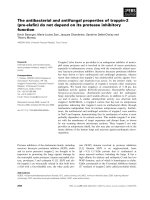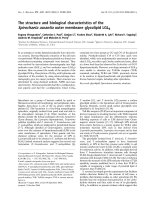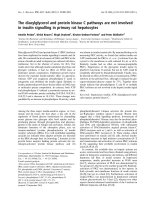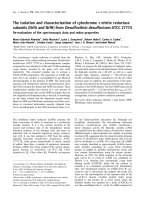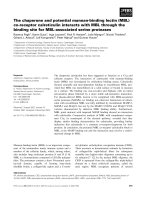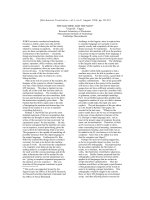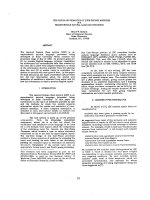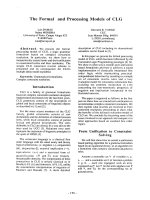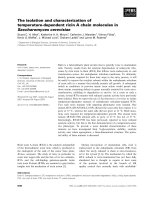Báo cáo khoa học: "The influence of cork oak pruning on the yield and growth of cork" pps
Bạn đang xem bản rút gọn của tài liệu. Xem và tải ngay bản đầy đủ của tài liệu tại đây (514.02 KB, 8 trang )
I. Cañellas and G. MonteroEffect of pruning on cork production
Original article
The influence of cork oak pruning on the yield and growth of cork
Isabel Cañellas
*
and Gregorio Montero
Silviculture Department, CIFOR-INIA, Apdo. 8.111, 28080 Madrid, Spain
(Received 8 February 2001; accepted 22 April 2002)
Abstract – Bearing in mind the importance of pruning as a silvicultural treatment in cork oak (Quercus suber L.) open woodland of the dehesa
type, an experiment was designed to assess the effect of pruning on cork yield. This work was carried out in two ways: synchronically, compa
-
ring pruned sites with others which were either unpruned or pruned at different times, and diachronically, comparing pruned and unpruned trees
within the same site.The five test sites (with forty trees in the synchronic and eighty in the diachronic plots) were selected in south-west Spain. In
all cases measurements of the cork production were made in kilos per square metre of surface stripped, total cork yield per tree, and the mean
thickness of stripped cork. Analysis was carried out using a paired data comparison test. The effect of pruning on yearly cork growth was also
analysed by examining the annual growth rings. In the five plots analysed there were no significant differences (95% confidence intervals) bet-
ween pruned and unpruned trees in terms of kilos of cork produced per square metre of surface stripped, nor for total cork yield per tree. Neither
were there significant differences in annual cork growth rings, even when the pruning was carried out during the cork-stripping period.
Quercus suber / pruning / cork production / pruned biomass / cork growth
Résumé – Influence de l’élagage du chêne-liège sur la croissance et la production de liège. Étant donné l’importance de l’élagage comme
traitement sylvicole habituel dans les pâturages de chêne liège (Quercus suber L.) du type dehesa, une expérience a été réalisée pour déterminer
l’effet de l’élagage sur la production de liège. Ce travail a été mené en suivant deux démarches : d’une part (étude synchronique) en comparant
des placettes élaguées et non élaguées, ou bien élaguées à différents moments, et d’autre part (étude diachronique) en comparant dans la même
placette des arbres élagués et non élagués. Les cinq placettes d’essai (40 arbres dans les placettes synchroniques et 80 arbres dans les diachroni
-
ques) ont été choisies dans le sud-ouest de l’Espagne. Dans tous les cas, les kilogrammes de liège produits par mètre carré de surface décortiquée,
la production totale de liège par arbre et l’épaisseur moyenne du liège récoltée ont été mesurés. L’analyse statistique a été réalisée avec un test de
comparaison de données couplées. L’effet de l’élagage sur la croissance annuelle du liège a été aussi analysé en étudiant les cernes de croissance.
Dans les cinq placettes analysées, aucune différence statistiquement significative (95 % d’écart de confiance) n’a été observée entre les arbres
élagués et les non élagués pour les kilogrammes de liège produits par mètre carré de surface décortiquée, ni pour la production totale par arbre.
Aucune différence n’a pas non plus été trouvée entre les cernes de croissance du liège, même quand l’élagage a été réalisé pendant la période de
décorticage.
Quercus suber / élagage / production de liège / biomasse / croissance du liège
1. INTRODUCTION
The pruning of cork oaks, as carried out in the traditional
exploitation of open cork oak dehesa (open woodland), has
been controversial for long time, both in theory and in practi
-
cal application. However the available information is insuffi
-
cient to form an objective and rational opinion on this
important silvicultural and economic practice.
Some experiments were carried out in Portugal, designed
to determine the effects of pruning on cork growth, yield and
acorn production; and the results were published by
Natividade [11–14] and Santos and Rodrigues [17]. The only
experimental work in this field in Spain has been that of
Montero and Curras [10], designed to quantify firewood and
virgin cork obtained by moderate pruning.
The so-called formation pruning, to rectify deformed
trunks or branch distribution in the young tree, is highly valu
-
able in the long term. It increases the yield and enhances cork
quality by reducing the cork wastes and extraction costs.
The pruning of adults trees originates from the emulation
of holm oak (Quercus ilex subp. ballota) pruning, which
Ann. For. Sci. 59 (2002) 753–760 753
© INRA, EDP Sciences, 2002
DOI: 10.1051/forest:2002061
* Correspondence and reprints
Tel.: 34 91 3476867; fax: 34 91 3572293; e-mail:
results in more regular and sustainable acorn production, and
reduction in crown cover favouring cereal crops and the sup
-
ply of grazing for cattle.
Light or moderate pruning is good for the tree, in general,
ridding it of overshadowed or weak branches with a negative
energy balance, and for increasing the acorn yield. This is
particularly true on nutrient-poor soils and where there is a
summer water supply deficiency. This type of pruning does
not reduce diameter growth, and may even slightly increase it
at times [7, 8].
The economic costs of light or moderate pruning are, how
-
ever, very high. As a result, attempts to compensate for this
by incoming from firewood, charcoal or virgin cork, lead to
increase the intensity of pruning. Thus, pruning is usually
very intensive or even excessive. This in turn means that
pruning may have to be carried out more often, in order to
correct imbalances in the crown.
Another drawback of intense pruning is that it is followed
by periods of little or no fruit production, since allocation is
made to crown restoration and reduce the imbalance between
aerial and root biomass, usually by means of sucker sprouts
or epicormic shoots. Such excessive pruning is not justified
from the point of view of fruit production, since it reduces the
productive surface. Although there may be abundant acorns
on the few remaining branches, this has not been shown to re-
sult in increased overall production. Moreover, the remaining
crown surface available for photosynthetic activity may be so
reduced as to lead to a serious slowing of diameter growth
[7].
However the lack of knowledge about the effect of
silvicultural practices (e.g. pruning thinning, debarking lev-
els) that are usually applied in cork oak stand management,
on tree and cork growth, make difficult the develop and vali
-
date growth and yield models for cork oak stands [16].
For these reasons, we set up experiments with the aim of
quantifying the effect of pruning on cork yield. This was done
by comparing pruned with unpruned trees in relation to cork
yield per tree, production of cork for each square metre
stripped, and annual cork growth. Other aspects of physio
-
logical nature were not taken into consideration.
2. MATERIALS AND METHODS
2.1. Description of experimental sites
This work was carried out in two ways: synchronically, compar
-
ing pruned sites with others which were either unpruned or pruned at
a different time, and diachronically, where pruning was performed
in the middle of the cork-cropping cycle within a group of trees,
comparing these with others which had not been pruned.
2.1.1. Synchronic study: characteristics of the sample
The choice of sites was made after a complete examination of the
cork oak dehesas of Cáceres province. The advantage of this type of
woodland was that it allowed sites to be selected in which there had
been pruning in previous years, thus allowing us to measure the re
-
sponses of the tree to treatment without having to carry out the treat
-
ment first and then wait for a whole cork-cropping cycle to pass. It
also allowed us to quantify the effects of pruning carried out many
years before. One disadvantage is that we do not have information or
proper estimates assessing the intensity of pruning.
In each plot, trees were selected to cover the whole of the exist
-
ing diameter range, and so that the treatments (pruned/unpruned
trees, or those with different pruning dates) could be represented by
paired data, with trees of the same or very similar circumference
over cork (COC), and similar stripping height of trunk (SH). The
paired trees were very close together, and had the same ecological
and silvicultural characteristics, with the exception of pruning treat-
ment. The sites (figure 1) are described as follows:
“La Hergüijuela”: Located in 39º 51’ N, 5º 55’ W, UTM: 30S
TK01. In 1994 a sample of 22 trees pruned in the winter of 1990 and
another 22 trees, which had not been pruned for at least twenty years
were selected. Cork stripping was carried out in June 1994, after a
rotation cycle of eleven years.
Valcorchero wood, zone 1: Located in 40º 05’ N, 6º 10’ W,
UTM: 29S QE53. In October 1992 a sample of 20 trees pruned in the
winter of 1989, four years before stripping, and another 20 trees
pruned in 1980 (during the previous cork-production cycle) were se
-
lected. The cork stripping was carried out in July 1994, after a 10-
year cycle.
Valcorchero wood, zone 2: Located in 40º 05’ N, 6º 10’ W,
UTM: 29S QE53. In October 1992 a sample of 20 trees pruned in the
winter of 1991 and another 20 trees not pruned (for at least twenty
years) were selected. Cork stripping was carried out in June 1995,
after a 10-year cycle.
754 I. Cañellas and G. Montero
Figure 1. Location of experimental sites in Extremadura region (Spain).
The climate is continental Mediterranean and the potential vege
-
tation is that of the Sanguisorbo agrimonioidis-Quercetum suberis
[15] type of cork oak forest in all of the sites.
The two sub-sections of each site were laid out together, so that
the trees inside them were as similar as possible in size, appearance,
silvicultural characteristics and state of health. In this way, any dif
-
ferences in yield could be attributed mainly to the pruning treatment
carried out. The intention, then was to compare trees pruned three or
four years before stripping with others pruned 13–14 years before
(i.e. during the previous cycle), or not pruned for at least twenty
years.
2.1.2. Diachronic study: characteristics of the sample
In order to maintain a rigorous control over the treatment, prun
-
ing was carried out in two test areas. This was performed by staff
used to this kind of silvicultural treatment, but advised and checked
by ourselves. Thus the intensity of pruning on all trees was similar,
and was evaluated at the same time.
“El Dehesón del Encinar” estate: Located in 39º 50’ N,
5º 05’ W, UTM: 30S UK23. Pruning was carried out in December
1993 on 40 trees, and these were compared with 40 others left un
-
pruned. Cork stripping took place in August 1998, at the end of a
ten-year cycle.
“Las Cansinas del Oeste” estate: Located in 39º 58’ N, 6º W,
UTM 30S TK51. Pruning was carried out in December 1993 on
40 trees, and these were compared with 40 others left unpruned.
Cork stripping was in June 1998, after a 9-year cycle.
Both sites have a continental Mediterranean climate and the po-
tential vegetation of the area where data was gathered is that of
Sanguisorbo agrimonioidis-Quercetum suberis type of cork oak
forest according to Rivas Martínez [15].
The trees were selected in pairs according to their circumference
over cork at breast height, covering all the diameter classes present
in the area. One of the samples consisted of 40 trees which were not
going to be pruned, and the other of 40 trees which were pruned four
years after stripping.
The pruning consisted mainly of eliminating low branches wher
-
ever possible, reducing crown diameter, leaving some branches in
the middle of the crown which would overshadow first-order
branches and assure a round-shaped crown. Particular attention was
paid to avoid rot, by not leaving horizontal cut surfaces liable to ac
-
cumulate of rainwater. Attention was also paid to maintain crown
balance and branches above 20 cm base diameter were not cut. The
remaining branches were cleaned of dry or withered twigs [10].
It is difficult to quantify the intensity of pruning, since this de
-
pends on the initial number of branches and the number of branches
cut off. Effort was made not to cut more than 30% of crown volume,
only exceeding this limit where the shape of tree or crown made it
advisable for the future growth of the tree. A rule maintained by spe
-
cialists is that the ideal intensity of pruning is that where the tree
does not respond by throwing out suckers, or at least only very few.
In the two sites only 8% and 10% of the trees sprouted relatively pro
-
fusely, indicating that they had been pruned more heavily. It can
thus be deduced that pruning was of moderate to strong intensity.
The pruning intensity was estimated considered the biomass cut
off in relation with the circumference over cork by tree according
with Montero and Curras [10].
2.2. Data gathering
In each plot the trees were individually identified and numbered,
and the following data measured:
– Breast height circumference over cork (COC) and under cork
(CUC) to the nearest centimetre.
– Base circumference (BC), mid-point (MC) and the top (TC) of the
trunk in centimetres.
– Height of cork stripping in trunk (SH), to the nearest centimetre.
– Mean circumference (BC
i
) and stripped length (BL
i
) of each
stripped branch.
– Total cork weight (green matter), immediately after stripping, to
the nearest 25 g.
– Mean thickness of cork for each tree, calculated by averaging the
thickness of three cork planks selected at random immediately after
being removed from the tree, and the thickness measured at two
mid-points of each plank.
– Two pieces of cork measuring about 20 × 20 cm were random
collected from each tree and taken to the laboratory. A thin slice was
cut, one of its faces was sanded, and a microscope was used to mea
-
sure annual cork growth.
– Biomass cut off during pruning was weighed (in kg) for each
pruned tree in the El Dehesón del Encinar site (40 trees), and in an
additional sample of 27 trees selected so as to include all the diame-
ter classes present in the Las Cansinas site. Samples of biomass were
taken in order to estimate the humidity (oven-dried at 105 ºC till
constant weight). Later the biomass was sorted into two groups: fire-
wood (branches over 5 cm in diameter, with virgin cork) and brush-
wood (branches under 5 cm in diameter with leaves).
On the basis of the variables measured in the field, other vari-
ables were defined, characterising the tree as a producer of cork:
– Surface stripped from the trunk (SST), from branches (SSB) and
in total (SS).
– Weight of cork per square metre of stripped surface (WCSM) in
kg m
–2
.
– Mean thickness of cork (MTC), in mm.
– Coefficient of stripping (CS): quotient of the maximum length of
cork stripping and the beast height circumference over cork.
– Intensity of stripping (IS): quotient of the total stripped area (SS)
and the sectional area under cork at 1.30 m (CUC):
IS
SS
CUC
=
⋅
2
4 π
.
The stripping height on trunk and branches was maintained and
therefore no virgin cork was obtained from stripped trees.
2.3. Statistical treatment
Treatments were examined for statistically significant differ
-
ences. Variance analysis was carried out, taking the data as a design
of completely random blocks for each of the variables under consid
-
eration. Paired comparisons were also made, using the t-test.
In order to estimate the biomass removed, the variable most
closely correlated with weight was selected, and linearized
allometric equations were adjusted by Napierian logarithms.
Effect of pruning on cork production 755
3. RESULTS
3.1. Pruning quantification for Las Cansinas
and El Dehesón
Average figures for biomass obtained from pruning in the
plots in El Dehesón del Encinar and Las Cansinas are shown
in table I. Depending on the circumference classes, the bio
-
mass obtained from pruning ranged from 45–63 to
1440–1160 kg tree
–1
in green matter for Deheson and
Cansinas, respectively.
In the sample, the firewood had 36–38% humidity and the
brushwood 39–41% (57–61% in leaves and 38–40% in
brushwood without leaves) in the El Dehesón and Las
Cansinas sites respectively. Biomass increased with tree di
-
mensions as shown in figure 2. Table II shows the allometric
relations found in the sample.
There are statistically significant relationships between
the total biomass, firewood and brushwood and the breast
height circumference over cork. The adjusted models explain
66–78% of the variability of the variables, and can therefore
be considered acceptable.
3.2. Influence of pruning on cork yield
Table III presents information concerning the size of the
trees studied. Mean values for the plot are given, and, in order
to provide more detail about the sample analysed, the stan
-
dard mean deviation, and the maximum and minimum values
for circumference over cork.
The results per site (table III) showed a high variability in
most of parameters considered. The coefficient of variation
of the mean rate was 20% in most cases.
Table IV gives information concerning variables charac
-
terizing the tree as a cork producer, such as the height to
which the trunk is stripped, the total length of stripping, the
surface area stripped, and the indices and coefficients of
stripping which reveal the intensity of stripping.
The stripping coefficient (CS) is always under 2.6 in all
sites (table IV). Thus, the trees are not excessively stripped; if
this was not the case the objective of the study would be af
-
fected. However a tree stripped only on the trunk may have
the same coefficient as one stripped on both trunk and
branches, but has to withstand a much lower pressure of strip-
ping than the latter. In fact, when over a third of the surface
area stripped is on the branches, it is recommended not to ex-
ceed a value of 2.5 for the cork stripping coefficient [9].
The stripping index (IS) is a better indicator of stripping
pressure on a tree. In all the test sites except that of Las
Cansinas, the IS was between 29 and 33, lower than the val-
ues recommended by Montero [9], who refers that a cork har-
vest can be obtained in a rational manner with stripping
intensity values of less than 34–36. In the case of Las
Cansinas, where most trees have been stripped on both trunk
and branches, the stripping index is higher (45). We should to
bear in mind that the stripping index is expressed by the coef
-
ficient between the surface area stripped and the area of the
breast height section of the tree (1.30 m).
756 I. Cañellas and G. Montero
Table I. Biomass obtained from pruning (kg/tree, green matter) in El
Dehesón del Encinar (40 trees) and Las Cansinas (27 trees).
Circumfe-
rence over
cork, cm
Biomass, kg/tree
Firewood Brushwood Total
Dehesón
Mean 130 316 167 483
Maximum 212 1013 427 1440
Minimum 76 25 20 45
Stand. deviation 29 203 82 276
Cansinas
Mean 140 295 176 471
Maximum 190 879 407 1160
Minimum 95 30 34 63
Stand. deviation 26 205 89 284
Table II. Allometric relations between estimates of total biomass and
the firewood and brushwood biomass (kg/tree, green matter) ob
-
tained from pruning in the Dehesón del Encinar and the Las Cansinas
plots. The following linear model was used: Ln(Y) = Ln (a) + b ×
Ln(COC).
Sites
Y Ln(a) S(Ln(a)) b S(b) R
2
P value
Dehesón
Total
biomass
–7.2259 1.4090 2.7280 0.2908 70.96 0.0000
Firewood –9.1628 1.7057 3.0288 0.3521 74.01 0.0000
Brushwood –6.1724 1.3240 2.3002 0.2733 66.30 0.0000
Cansinas
Total
biomass
–9.7259 1.6846 3.1866 0.3420 77.64 0.0000
Firewood –11.941 1.8632 3.5318 0.3782 77.71 0.0000
Brushwood –7.8493 1.7355 2.6157 0.3523 68.79 0.0000
a and b: adjustment parameters; S(a), S(b): standard error of the estimate; COC: circumfe
-
rence over cork.
0
300
600
900
1200
1500
1800
75 100 125 150 175 200 225
Circumferece (cm)
kg/tree (green matter)
Dehesón
Cansinas
Figure 2. Total biomass (kg/tree, green matter) obtained from prun
-
ing in relation to normal circumference over cork for the plots in El
Dehesón and Las Cansinas.
In order to prove that there were no statistical differences
between the trees in each site, the paired data comparison test
was applied so as to analyse possible differences between
those variables measured directly in the field (COC, CUC,
BC, MC, TC, SH and LS) and those worked out from the pre
-
vious variables (SS, SST, SSB, IS and CS). This allows to as
certain that the sample analysed was homogeneous, and that
any differences in cork yield, would not be due to initial dif
-
ferences in the silvicultural conditions.
There were no significant differences (t-test analysis for
paired samples) for most of the variables, which seems to in
-
dicate that the silvicultural characteristics (tree size and in
-
tensity of cork stripping) of the paired trees are similar. In Las
Cansinas there were differences in total stripping length, and
thus in the indices measuring stripping intensity. These dif
-
ferences will need to be taken into account later when evalu
-
ating cork yield and thickness.
Table V gives mean values for the cork yield per tree and
per square metre of stripped surface, and the cork thickness
for each site and treatment. It can be seen that Valcorchero
(zone 1) has the highest mean yield values (>70 kg tree
–1
),
while Dehesón del Encinar shows the highest values of cork
weight per square metre stripped and of cork thickness. In
Las Cansinas, the higher stripping intensity did not appear to
have any negative influence on the mean cork production pa
-
rameters. The mean productivity was 9.74 kg m
–2
. Similar
values have reported by other authors [6, 14].
Table VI gives the results of the paired data comparison
test for the five sites. No significant differences were found
for any of the three production variables: mean yield per tree,
kilograms per square metre of surface area stripped, and cork
thickness.
The differences, with regard to stripping length and the in
-
dices of stripping intensity, between pruned and unpruned
trees in Las Cansinas, did not result in differences in the vari
-
ables quantifying cork yield.
3.3. Influence of pruning on growth
and thickness of cork
The cork growth rings for the two samples taken from each
tree at the time of stripping were measured, and an arithmetic
mean was calculated later. The results obtained for each site
and treatment are shown in figures 3, 4, 5, 6 and 7.
In the five figures only the whole cork growth years have
been represented. Thus for nine-year rotations there will be
Effect of pruning on cork production 757
Table III. Main silvicultural characteristics of the experimental sites.
Table IV. Variation in stripped height, stripped surface and intensity of stripping in the experimental plots.
8 whole mean annual growths, and approximately two half-
years, corresponding to the first autumn following stripping
and the last spring before a final stripping. Similarly, for ten–
and eleven-year rotations.
The annual cork growth the year after stripping was not the
greatest in opposite the results reported by Ferreira et al. [4].
In our case, the greatest cork growth was obtained the second
or third year after stripping.
A high annual cork growth variability was observed in all
sites. This high variability could be explained through the
preponderant effect of the tree like source of variation [4].
758 I. Cañellas and G. Montero
0
1
2
3
4
5
12345678910
years
Mean annual cork growth
(mm)
P90
NP
Pruning
Figure 3. Cork growth rings in the La Hergüijuela test site. Year of
stripping 1994, 11-year rotation, pruning in 1990. NP denotes no
pruning trees for at least twenty years. P90 denotes pruned trees dur
-
ing the winters of 1990.
0
1
2
3
4
5
6
123456789
years
Mean annual cork growth
(mm)
P89
P80
Pruning
Figure 4. Cork growth rings in the Valcorchero zone 1 test site. Year
of stripping 1994, 10-year rotation, time since the last pruning 14 and
4 years respectively. P80 and P89 denote pruned trees during the win-
ters of 1980 and 1989 respectively.
0
1
2
3
4
123456789
years
Mean annual cork growth
(mm)
P91
NP
Pruning
Figure 5. Cork growth rings in the Valcorchero zone 2 test site. Year
of stripping 1995, 10-year rotation, time since the last pruning, in
1991, 4 years. NP denotes no pruning trees for at least twenty years.
P91 denotes pruned trees during the winters of 1991.
Table V. Variation in cork yield (kg tree
–1
and kg m
–2
of stripped surface) and thickness (mm) in the experimental sites.
Sites Treatment Year
of stripping
Mean yield WCSM thickness
mean s.d. mean s.d. mean s.d.
La Hergüijuela
pruning 1990
1994
36.38 14.21 8.78 2.01 28.33 5.13
no pruning 42.04 14.21 9.74 1.02 31.06 4.32
Valcorchero 1
pruning 1980
1994
75.31 41.82 9.54 1.54 32.06 4.16
pruning 1989 71.83 34.14 10.22 3.06 32.97 6.35
Valcorchero 2
pruning 1992
1995
33.33 18.81 8.22 1.31 26.55 3.92
no pruning 35.64 20.85 8.52 1.26 27.13 3.08
Dehesón
pruning 1993
1998
45.68 27.00 11.30 2.22 33.29 5.92
no pruning 51.54 25.69 11.51 2.18 35.02 5.68
Cansinas
pruning 1993
1998
59.02 34.25 9.90 2.46 28.82 5.75
no pruning 55.06 30.60 9.68 2.14 30.32 6.47
Mean yield: kg tree
–1
; WCSM: kg of cork per m
2
of stripped surface; s.d.: standard mean deviation; Thickness: mm.
Table VI. t-test analysis for paired samples, confidence interval 95%,
for each of the product variables defined.
Sites Treatment Mean yield WCSM Thickness
La Hergüijuela pruning 1990/NP n.s. n.s. n.s.
Valcorchero 1 pruning 1980/89 n.s. n.s. n.s.
Valcorchero 2 pruning 1992/NP n.s. n.s. n.s.
Dehesón pruning 1993/NP n.s. n.s. n.s.
Cansinas pruning 1993/NP n.s. n.s. n.s.
Mean yield: kg tree
–1
; WCSM: kg of cork per m
2
of stripped surface; n.s.: no significant dif-
ferences at 95% confidence level; NP: no pruning.
In order to analyse the differences between growth rings
the paired data comparison test was applied to the five test
sites. There were no cases of significant difference in the cork
annual year growth for the year of pruning, nor in the follow
-
ing years when compared with the unpruned trees.
In the years previous to the pruned, some differences were
to find in the cork annual growth of the two groups of trees: in
the Hergüijuela site in 1986 and 1987, and Las Cansinas sites
for 1993.
Cork growth differences before and after pruning were
analysed in every tree. No significant differences between
pruned and unpruned trees were found for each experimental
site.
4. DISCUSSION
As we have mentioned, our methods were designed to en
-
sure that pruning did not exceed 30% of total crown biomass,
and at first sight this seemed to be the case. However, when
comparing the data for biomass extracted and for circumfer
-
ence over cork (table I) with those published by Montero and
Curras [10] for the Cáceres area (for circumference classes
between 130–140 cm the biomass obtained from moderate
pruning was 2103 kg tree
–1
in green matter of firewood and
130 kg tree
–1
in green matter of brushwood), it appears that at
times almost 40% of total crown biomass was pruned. It can
be concluded that the pruning figures obtained in these two
sites are considerably higher than those presented by the lat
-
ter authors, for two main reasons: the pruning carried out in
the Montero and Curras [10] study was relatively moderate,
while in the present study the trees in the sample had not been
pruned for a long time, and had abundant woody biomass in
the crown. As we remarked in the Methods section, fre
-
quency of pruning is a determining factor in its intensity.
The equations obtained for estimating the woody biomass
pruned conform with the methodology usually employed in
these studies [1–3, 5], and fit the measured data well in all the
fractions analysed. Although the data were not sorted accord
-
ing to units of surface area, the equations derived from tree
diameters would allow to estimate fairly accurate woody bio
-
mass pruned in a dehesa of a certain density and mean tree
size.
This model could be considered like an approach to esti-
mate de firewood with pruning in cork oak woodlands. Al-
though the model only included like independed variable the
breast height circumference, we have to take in account the
height of these trees (pruning every 15–20 years) do not im-
prove, normally, the adjustment.
There is not much data from earlier studies on the effect on
pruning on cork yield with which to compare the results ob-
tained from this study.
According to Natividade [13] the benefits obtained from
rational pruning, carried out with biological rather than pro
-
ductivity-oriented aims, are indisputable; it creates better
conditions for the cork-generating layer, rejuvenates the
branch system, and increases growth rate and cork yield. Our
results do not appear to confirm this, since neither the mean
cork yield per tree, nor per square metre stripped, nor cork
thickness seem to be affected by pruning. We may even con
-
sider the hypothesis that pruning, even of moderate intensity,
results in an imbalance between the aerial and root biomass
which, in turn, diverts energy to leaf production at the ex
-
pense of cork yield.
From the point of view of cork yield, Natividade [11, 12]
showed that an excessively pruned cork oak forest yields
20% less cork than others with similar characteristics (age,
and silvicultural and ecological conditions) which had been
moderately pruned, as a results from a diameter growth de
-
crease of 20% in the excessively pruned plot.
We did not find this reduction in cork production immedi
-
ately after pruning, presumably because pruning was not ex
-
cessive on any of the trees in the five test sites. But neither we
Effect of pruning on cork production 759
0
2
4
6
8
123456789
years
Mean annual cork growth
(mm)
P93
NP
Pruning
Figure 6. Cork growth rings in the El Dehesón del Encinar test site.
Year of stripping 1998, 10-year rotation. Pruning winter in 1993. NP
denotes no pruning trees for at least twenty years. P93 denotes pruned
trees during the winters of 1993.
0
1
2
3
4
5
6
12345678
years
Mean annual cork growth
(mm)
P93
NP
Pruning
Figure 7. Cork growth rings on the Las Cansinas test site. Stripping in
1998. 9-year rotation. Pruning winter in 1993. NP denotes no pruning
trees for at least twenty years. P93 denotes pruned trees during the
winters of 1993.
did note an increase in cork yield, as did Natividade [13],
when pruning was not excessive.
In our experiment the effect of pruning on cork thickness
was measured in the immediately following years in four test
sites, and the possible longer-term effects of pruning carried
out before the current cork rotation period were measured in
one test site.
In Valcorchero, zone 1, (figure 4) the effects of pruning
carried out four years before stripping (P89) were compared
with that carried out fourteen years before stripping (P80).
The results showed no significant differences in cork growth.
In Valcorchero, zone 2, (figure 5) and La Hergüijuela (fig
-
ure 3) unpruned trees, or those pruned over twenty years be
-
fore (NP) were compared with those pruned four years before
the last stripping. This case, too, failed to reveal statistically
significant differences in cork yield or yearly growth.
In the Las Cansinas (figure 7) and El Dehesón (figure 6)
test sites, trees pruned four years before stripping were com
-
pared with unpruned trees. Results in these two sites can be
regarded as duplicating those in Valcorchero, zone 2, and in
La Hergüijuela, though the additional information obtained
about pruning intensity enables us to draw conclusions with
greater confidence. In these cases, too, failed to reveal statis-
tically significant differences in cork yield or yearly growth.
The varied nature of the test situations in this experiment
cover a fairly wide range of the possible situations related to
pruning in a cork oak forest. This, together with the ecologi-
cal and silvicultural variability of the cork oak forests in
which the experiments were carried out, permit us to assign a
high degree of reliability to the results.
These results mean that we do not have to take common
silvicultural practices like pruning into account when devel
-
oping of growth and yield models cork production in cork oak
stands. The effects in wood growth are not known until now.
Other effects produced by pruning damage, such as infec
-
tion by fungi or insects, rotting, torn branches or physiologi
-
cal problems have not been measured in this experiment.
CONCLUSIONS
Pruning of strong (but not excessive) intensity does not
significantly influence the quantity of cork produced by a
tree, nor the cork produced per square metre of the stripped
surface area, nor the thickness of annual growth produced af
-
ter pruning. These results mean that we do not have to take
common silvicultural practices like pruning into account
when developing of growth and yield models cork production
in cork oak stands.
Other effects produced by pruning damage, such as infec
-
tion by fungi or insects, rotting, torn branches or physiologi
-
cal problems have not been measured in this experiment.
Acknowledgements: Our thanks go to all the owners of the sites,
the Forest Service of the province of Cáceres for allowing us to re
-
cord data, and all those involved in the collection of field and labora
-
tory data, particularly A. Bachiller, Mª A. Suarez and E. Torres. The
authors also thank C. Farrel for the paper translation.
REFERENCES
[1] Cañellas I., San Miguel A., Del Río V., Evaluación de la producción
silvopastoral de una dehesa extremeña: pasto, bellota y biomasa de ramas po
-
dadas, XXXI Reunión Científica de la SEEP, Murcia, in: Congresos 4, Conse
-
jería de Agricultura, Ganadería y Pesca de la Región de Murcia, 1989, pp.
234–240.
[2] Cañellas I., San Miguel A., Biomass of root and shoot systems of Quer
-
cus coccifera shrublands in Easter Spain, Ann. For. Sci. 57 (2000) 803–810.
[3] Elk A.R., A model for estimating branch weight and branch leaf weight
in biomass studies, For. Sci. 25 (1979) 303–306.
[4] Ferreira A., Lopes F., Pereira H., Caractérisation de la croissance et de
la qualité du liège dans une région de production, Ann. For. Sci. 57 (2000)
187–193.
[5] Gomez A.G., Tovar J.J., Medina M., Martinez A., Relaciones entre diá-
metro de tallo y peso de las ramas en cuatro especies leñosas mediterránea,
Arch. Zootec., 25 (1986) 149–154.
[6] González Adrados J.R., Montero G., Ortega M., Caracterización pro-
ductiva de los alcornocales catalanes, Investig. Agrar., Sist. Recur. For. 2
(1993) 55–69.
[7] Hawley R.C., Smith D.M., Silvicultura Práctica, Omega, 1972.
[8] Hubert M., Courrand R., Poda y formación de los árboles forestales,
Mundi-Prensa, 1989.
[9] Montero G., Modelos para cuantificar la producción de corcho en al
-
cornocales en función de la calidad de la estación y de los tratamientos selvíco
-
las, Tesis Doctorales, 75 INIA Madrid, 1987.
[10] Montero G., Curras R., La poda del alcornocal (Quercus suber L.).
Cuantificación de sus productos, Hojas divulgadoras, MAPA, No 18–19,
1990.
[11] Natividade J., Poda dos sobreiros, Sep. Bol. Min. Agric. XIII (1932)
1–29.
[12] Natividade J., Técnica cultural dos sobreirais, I Poda, Junta Nacional
da Cortiça, Lisboa, 1937.
[13] Natividade J., A propósito da arreira, in: Campanha de Protecçao do
sobreiro, I. Poda, Junta Nacional Cortiça, Lisboa, 1947, pp. 13–25.
[14] Natividade J., Subericultura. Dir. Geral dos Ser. Florestais e Aquico
-
las, Lisboa, (Spanish edition 1992), M.A.P.A., Madrid, 1950.
[15] Rivas Martínez S., Memoria del Mapa de Series de Vegetación de
España, ICONA, Madrid, 1986.
[16] Tomé M., Coelho M.B., Pereira H., Lopes F., A management oriented
growth and yield model for cork oak stands in Portugal, Empirical and process
based models for forest tree and stand growth simulation, Amaro A., Tomé M.
(Ed.), 1999, 271–289.
[17] Santos B., Rodrigues F., Do podador de sobreiros e do tirador de corti
-
ça, Instituto dos Produtos Florestais, 1975.
760 I. Cañellas and G. Montero
